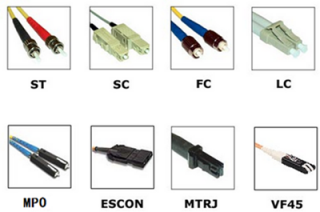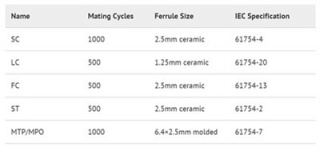A Rundown of Fiber Optic Connectors
petak , 17.06.2016.During the rapid development of fiber optic technologies over the past decades, fiber product manufacturers and companies have released countless sophisticated equipment, during which the so-called “better mousetrap”—fiber optic connectors attract users’ attention. These smart connectors are used to terminate at the ends of fiber optic cables to form fiber optic jumper, like fiber cable LC to LC. Since a variety of splice options are available to fiber network planners today, connector types are diversified, eg. ST, SC, LC, MTP/MPO connectors. Each connector has its own unique design and therefore, pros and cons. Then question occurs, how to choose the suitable ones that are lower loss, lower cost, easier to terminate or to solve some other perceived problems? Have some ideas? If not, don’t worry. Here is a rundown of several leading connector types, introducing their strengths and weaknesses respectively.
Fiber Optic Connector Design
Most fiber optic connectors are known to be pluggable male connectors with a protruding ferrule that holds the fiber optic cables and aligns them for mating. They use a mating adapter to mate the two connector ferrules that fit the securing mechanism of the connectors (bayonet, screw-on or snap-in.). The ferrule design is also useful as it can be used to connect directly to active devices like LEDs, VCSELs and detectors. Image below helps you to get the idea of different connector sizes.
Fiber Optic Connector Color Codes
In earlier ages, single-mdoe connectors are always in yellow, while multi-mode ones in orange, black or gray. But the advent of such metallic connectors as FC and ST made color coding difficult, so colored boots were often used. The TIA 568 color code for connector bodies and/or boots is Beige for multi-mode fiber (MMF), and Blue for single-mode fiber (SMF), and Green for APC (angled) connectors.
Fiber Optic Connector Types
Table listed below shows differences among several most common fiber optic connectors.
SC Connector
SC, sometimes referred to as square connector, was developed by the laboratories at Nippon Telegraph and Telephone (NTT) in the mid-eighties. Standardized in TIA-568-A, the SC has a push-pull coupling end face with a spring loaded 2.5mm ceramic ferrule. At first, SC was not widely used because of its high cost, but with manufacturing costs coming down, it slowly grew in popularity in datacoms and telecoms applications including point to point and passive optical networking.
LC Connector
LC connector, licensed by Lucent Technologies, is a small form factor connector that utilizes a latch as opposed to the SC locking tab, and with a 1.25mm ferrule, half the size of the SC. It’s just because of its smaller size, LC becomes increasingly popular in datacoms and other high-density patch applications, as its combination of small size and latch feature make it ideal for densely populated racks/panels. With the introduction of LC compatible transceivers (say SFP-10G-SR) and other networking components, its steady growth in the communication arena is likely to continue.
FC Connector
Different to the plastic bodied SC and LC, FC uses a round screw-type fitment made from nickel-plated or stainless steel. The connector end face relies on an alignment key for correct insertion and is then tightened into the adaptor/jack using a threaded collet. Despite the additional complexity both in manufacturing and installation, it’s still the connector choice for precise measuring equipment such as OTDRs.
ST Connector
ST was developed by AT&T. Judging from appearance, ST and FC are almost the same, except that ST uses a bayonet fitment rather than a screw thread. The introduction of SC and LC has reduced the usage of ST and FC, since SC and LC deliver similar performance to ST and FC, but both have less expensive components and are quicker to connect. Additionally, ST cannot be terminated with an angled polish, which limits use in SMF and FTTH applications.
MTP/MPO connector
Just like SC, MT ferrule connector is also NTT’s invention coming in the 1980s. But this technology has only recently become popular under branded versions of the multiple fiber push-on/pull-off connector, such as MTP and MPO. It is larger than the other connectors but for good reason - it can support up to 24 fibers in a single ferrule. They are extensively used in high density patch environments such as data centers they are used extensively, both at single mode and multi-mode wavelengths.
It’s known that the sequence of the fibers cannot physically be changed after termination, so MTP/MPO connector is supplied with a fan-out assembly at the opposing end, such as LC. This allows the operator to change channels simply by re-patching the fanned-out side of the cable.
Conclusion
After description, it’s easy to identify these connectors and choose the right ones for your networking use according to their design and usage. Fiberstore supplies various kinds of connectors with high quality and at low prices. Besides, connector compatible fiber patch cords are also available, including fiber cable LC to LC mentioned above, SC SC fiber cable, ST ST fiber cable, and so on. You can visit Fiberstore to know more information about fiber optic connectors and their compatible fiber cables.
Oznake: fiber optic connectors, SC, LC, FC, st, MTP/MPO, fiber cable LC to LC, SC SC fiber cable
komentiraj (0) * ispiši * #


